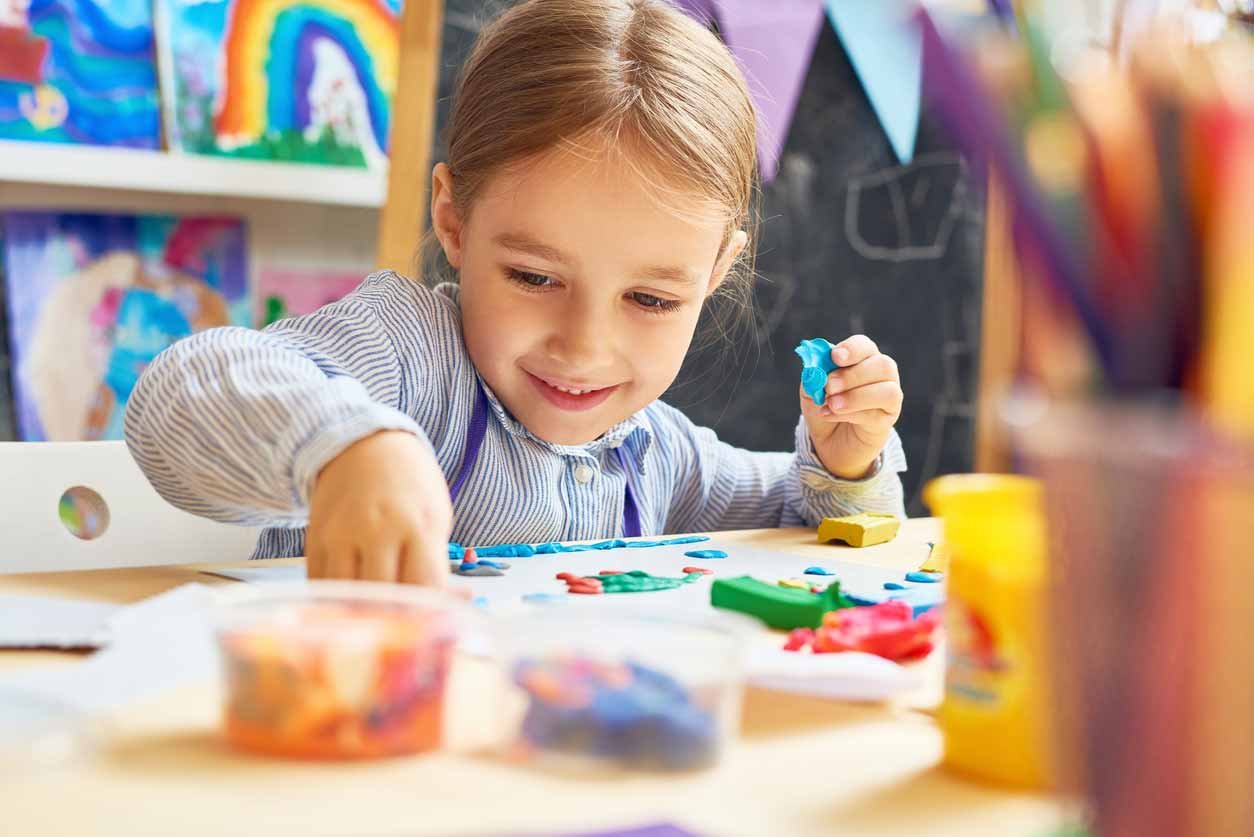
How to incorporate STEM education into Kindergarten Curriculum
An early start to STEM education is essential for developing the foundations of STEM fluency, which includes:
- The ability to think critically and logically
- The ability to solve problems creatively
- The confidence to engage with the world fearlessly
Introducing these core concepts of STEM in kindergarten prepares young minds to approach their education with curiosity, innovation, and confidence. Just like learning a new language, young minds can grasp onto these concepts quickly and start practicing the fundamental skills that they’ll use for the rest of their lives.
This early introduction to STEM concepts is vital. It prepares students for their entire educational journey and influences how they approach obstacles in and outside of the classroom. Equally important for early success is a properly structured, age-appropriate, and well-instructed STEM curriculum to cultivate STEM fluency. Without this, young students can feel unchallenged, overwhelmed, discouraged, or confused by a curriculum that doesn’t meet them at their level.
Studies show that discouraged students can carry these feelings throughout the rest of their educational careers and beyond. In a 2015 study by the National Bureau of Economic Research focused on the unconscious biases of elementary teachers, researchers found that the early experiences students have with math and science in elementary school had a quantifiable effect on their future careers and earnings. The effects were even greater for those students who came from low-income families.
Eliminating unconscious biases from teachers through proper education and tools is just a piece of the puzzle. Instilling early STEM fluency also relies on a comprehensive curriculum level that starts at the earliest grade level in elementary school: Kindergarten.
What is the goal of STEM education at the kindergarten level?
Between ages four and seven, children are naturally creative and instinctive designers with active imaginations. While the sparks of these skills are often naturally evident, it’s important to cultivate, encourage, and develop these skills further for their educational success beyond Kindergarten.
The goal of STEM instruction at the kindergarten level is to create STEM-literate students and inspire a lifetime of STEM learning. Fostering an early positive relationship with science, technology, engineering, and mathematics can impact a child’s future beyond their educational career and influence their upward mobility and future earnings. Creating STEM-literate students in Kindergarten is done by fostering curiosity, creativity, and confidence with STEM activities and integrated STEM instruction.

For many young learners, Kindergarten will be their first formal introduction to the concepts of STEM, and in schools with underserved and underrepresented students, this can be especially true. Introducing STEM with a structured and kindergarten-specific curriculum can help educators meet the varying skill levels so that all students can succeed in their individual STEM journeys.
Designing STEM Curriculum for Kindergarten
When designing a structured STEM curriculum for the kindergarten level, it’s important to meet students where they are developmentally.
Cognitively, kindergarteners are in the “Preoperational State” of Jean Piaget’s 4 Stages of Cognitive Development. This is when a child’s memory and imagination are at their fullest and they are learning the foundations of abstract thought, language, and symbolism. They understand the concepts of the past and the future, and practice all of these elements through symbolic play, or “pretend play.” A Kindergarten STEM curriculum can exercise the pathways of this cognitive development with activities that focus on sequential ordering, pattern recognition, memory recall, and symbolic thinking.
Socially, children at this age interact with each other through play. Small group activities and group participation help children grow confidence in interacting with others. Classroom activities can be designed to incorporate play and social elements, such as pairing students to complete a project together, working in small groups at stations, or solving a problem together as a class. Smaller group activities also allow students who are initially shy to participate more without the attention of the entire classroom. They also help educators work with students with individualized attention, which can help address each student’s individual learning needs, and assist with teaching different levels of STEM fluency at once by partnering students with those at a similar level. In this way, all students remain challenged and engaged in the activity while practicing their social skills and playful nature.

Physically, children are further developing their fine motor skills and learning how to do more intricate movements and tasks like tying their shoes, cutting paper in a straight line, writing letters, and more. Incorporating physical activities into the STEM curriculum helps children grasp a physical understanding of the curriculum and engage with the physical world around them. This includes involving hands-on learning activities or using the outdoors to further enforce a new STEM concept. Tactile experiences and exploration can help solidify the new concepts of STEM and see its application in the world around them.
STEM Fluencies for Kindergarten Curriculum
With these developmental considerations in mind, a well-structured STEM curriculum for the kindergarten level incorporates these core skills:
-
Spatial Reasoning
This is the ability to envision objects or ideas in three dimensions. At this age, building activities can be a fun way to incorporate spatial reasoning into the curriculum. Students can follow written instructions to build a physical object (two-dimensional to three-dimensional); rearrange geometric shapes to create new shapes (making different shapes out of triangles: diamond, hexagon, rectangle, etc.); or investigate the same object from different angles and viewpoints.
Spatial reasoning is closely linked to Mathematics and is important in both problem-solving and critical thinking. We use visualization and spatial reasoning to envision an object or a problem so that we can plan a successful approach, whether that’s parking a car, or solving complex equations. Exercising this skill early on can have a direct impact on a student’s later success in their STEM studies.
-
Sequence & Correspondence
With sequence and correspondence, students develop the ability to follow steps in order and place objects in a precise way. This helps students recognize patterns and make predictions in everything from daily routines, to ordering words for a sentence; and from counting to telling a story from beginning to end. Teaching this essential STEM skill in kindergarten helps students practice approaching a problem logically and dividing tasks into smaller steps. With mastery, sequencing is used to engineer entire systems across industries - and it all starts with simple counting and placing things in an order that makes sense. Later, these skills can be used to solve more complex problems, but an established foundational fluency at the Kindergarten level adds a boosted head start.
-
Creative Problem Solving
The ability to work through problems and find different solutions to solve them is an essential life skill as well as a foundational skill for STEM fluency. Giving young students the opportunity to solve a problem creatively celebrates their unique perspective and helps students recognize the many different ways to approach a problem. This builds confidence and flexible thinking that can be applied to almost every aspect of education and life.
STEM Integration Into Kindergarten Curriculum
STEM education doesn’t need to be an isolated subject in the classroom. In fact, integrating STEM concepts into other school subjects is very effective in developing these skills. With early STEM fluency focused on spatial reasoning, sequencing, correspondence, and creative problem-solving, these skills can be incorporated into the classroom curriculum in a variety of ways.
- Freeplay
Allow students time to explore and create solutions to problems with space and freedom. Mixing freeplay with building blocks or craft supplies with structured activities allows students to apply newly-learned concepts and skills in a creative way. This reinforces the curriculum and makes learning fun and exciting.
- “What happens next?”
Help young students identify patterns and make predictions in the classroom and in the real world. Adding in the opportunity for students to guess what happens next whether during storytime or classroom routines helps students recognize the logical nature and sequence of things.
- Cultivating Curiosity
Cultivating curiosity in the classroom benefits all areas of study, especially in STEM. Encourage young students to ask questions and be curious about how things work or guide them into investigating an object or a problem from different perspectives. When young minds are curious to understand how things work, they start to build the skills necessary to engineer their own solutions and systems.
These classroom integrations not only solidify the concepts being taught in your STEM lessons but further connect these concepts to other subjects and topics—exposing young students to the versatility and connectivity within the STEM landscape.
How to Support Teachers in Kindergarten STEM Curriculum
Curiosity, innovation, and confidence in STEM subjects can all be cultivated in the kindergarten classroom - regardless of previous access or introduction to STEM. To do so effectively requires a structured and consistent curriculum that is familiar and comfortable for the educator.
This might require additional training for teachers or the incorporation of a system at the administrative level that includes all grade levels. Students benefit from a clear and progressive pathway to continue the development of their STEM skills when a complete curriculum system is installed.

Within a comprehensive curriculum system, educators are also equipped with activities and tools that are tailored to their student's grade level and assist students in building skills that they will use for the following grade levels. By providing the tools and resources teachers need, they can now focus their time and efforts inside the classroom rather than being responsible for sourcing materials, creating lesson plans, and teaching the designated curriculum. Empowered by professional learning tools and an all-in-one programming solution, teachers can be positive and inspiring STEM mentors for their students.
Tackling the Barriers to Introducing Kindergarten STEM Curriculum
While most educators and administrators would be delighted to implement a comprehensive all-in-one solution across grade levels that starts in Kindergarten, budget, curriculum, and district limitations may be at play. Here are a few ideas to overcome the barriers and still build the essential STEM fluencies in Kindergarten and beyond:
- Apply for the Kid Spark Education STEM Equity Grants Program
At Kid Spark, we believe that students of all backgrounds should have access to STEM education. Unfortunately, too many schools don’t have the resources to invest in a new STEM curriculum. That’s why we offer grants to provide public schools serving a high percentage of Title 1 students with comprehensive STEM programs to disrupt the pattern of educational inequity.
District curriculum budgets are often designed to address already-established core curricula, sometimes to comply with larger standards at the state or federal level. This leaves little room for funding an entirely new curriculum. That’s where STEM Enrichment can help. Enrichment curriculum is often decided at the school level which gives more freedom to administrators to invest in these valuable resources for their students.
- Incorporate STEM Curriculum into Afterschool Programs
Another way to get around core curriculum budgetary constraints is to add STEM curriculum into afterschool programming. Here, you can find outside financial support and participation from other community organizations such as libraries, non-profits, or local businesses. While this isn’t the most ideal option (as it can leave many students out), getting the curriculum in the school—in any form—can help validate later requests to install a comprehensive curriculum across multiple grade levels.
- See if Your School Qualifies for EANS Funding
Financial assistance might still be available for non-public schools to invest in a new Kindergarten STEM curriculum through the Emergency Assistance to Non-Public Schools funding issued through the American Rescue Plan Act in 2021. Designed to address the learning gap created by the COVID-19 pandemic, the federal EANS funding was given to all fifty states to disperse among non-public schools serving low-income households. You can read more about EANS funding and how to see if your school qualifies in this guide.
Start a Comprehensive Kindergarten STEM Curriculum with Kid Spark Education
Kid Spark programs are designed to provide all the resources needed to build solid foundational fluencies in students while giving teachers the tools they need to feel confident in the teaching materials. This includes:
- A comprehensive curriculum designed for each grade level from Pre-K through Grade 8. The STEM concepts introduced in the Kindergarten curriculum will set the foundation for future concepts in future grade levels with a progressive curriculum that keeps students challenged and engaged. From engineering to computer science, Kid Spark programs include complete teacher lesson plans, student workbooks, design challenges, evaluation rubrics, and unit assessments in printed and digital formats.
- STEM Labs with reusable engineering components to support students’ hands-on learning. In these labs, you’ll find everything you need to bring exciting new STEM activities to your classroom—all with the curriculum support you need to guide your class through each lesson.
- Professional Development courses through Kid Spark’s online learning management system. Here, educators can find a library of professional learning resources and materials so you feel confident and prepared to lead the next generation of STEM leaders!
If you’re interested in bringing Kid Spark’s STEM programs to your kindergarten classroom, get in touch with us. We’d love to find ways to support your classroom and bring research-backed STEM education to your students.
.png?width=1270&height=453&name=Copy%20of%20Kid%20Spark%20Logo%20(Horizontal%20-%20Full%20Color).png)